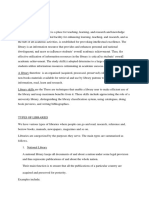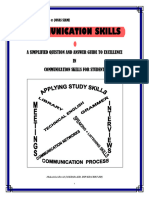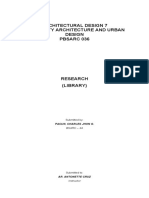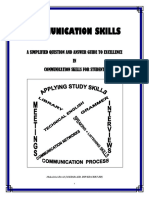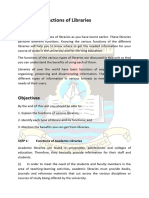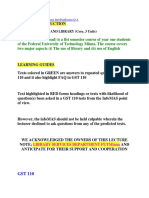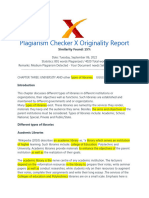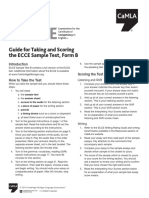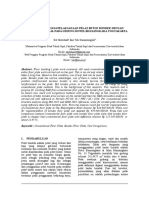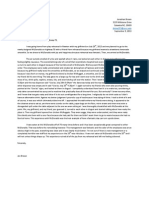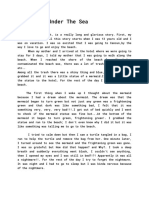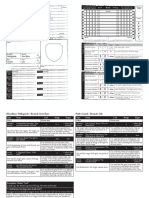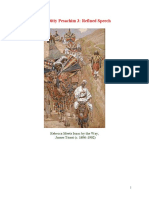KABARAK UNIVERSITY LIBRARY
LIBRARY SKILLS
Definition of a Library
According to the Encylopedic Dictionary of Library Science and Information Technology, a
library is collection of books and other literary materials which have been kept for reading, study
and consultation. It could also mean a place, building, room(s) set apart for the keeping and use of
a collection of books. (Rawat, 2002)
A library is a collection of selected information resources which are organized and preserved for
reading, studying and consultation.
Selected: Most university libraries select their materials using internationally accepted principles
of selection and correct selection tools. All materials acquired through gifts and donations should
be selected and only relevant and useful ones are put on the shelves.
Organized: It is only possible to use the collection in the library if it is properly organized.
Materials are organized by means of classifying and cataloguing. By classifying, library materials
are grouped together according to subject similarity and it is assigned a call number that enables
users to locate materials. By cataloguing, the users are informed of what is available in the library
stock/collection.
Preserved: Preservation is the maintenance of library materials in their original condition through
retention and proper care. If materials are damaged, they can be preserved through restoration (this
is the procedure that improves the condition of damaged objects and the attempt to reclaim it as
close as possible to original condition).
Reading, studying and consultation: Library materials are meant for leisure reading, e.g.
recreational; for study, e.g. textbooks; for consultation, e.g. reference materials.
Library user education or library skills
Library user education (also called library instruction) teaches users how to make the most
effective use of the library system. User education encompasses all activity undertaken to help
Page 1 of 19
�students become efficient users of information, i.e., how to identify the information need and then
how to find, evaluate, and select the best information to meet that need. Activities to achieve that
goal include orientation sessions, workshops, handouts, and course-related and course-integrated
instruction.
Aims
i) To train the user to exploit the library resources effectively.
ii) To provide the user with the skills for independent information seeking
iii) To encourage the user to seek the assistance of library professionals
TYPES OF LIBRARIES
NATIONAL LIBRARY
A Library designated and funded by a national government to serve the nation by maintaining a
comprehensive collection of the published and unpublished literary output of the nation as a whole.
Most national libraries are also responsible for compiling a national bibliography, and some also
serve as legal depository for works protected by copyright in the country, i.e. Kenya National
Library Services (KNLS), Library of Congress (USA.) etc. It is also called a reference library.
Usually books in such libraries are for reference only. The reference library is a copyright library
since its main function is to collect and preserve books, periodicals and newspapers published in
the country for posterity or prosperity. This is achieved through a law requiring publishers to
deposit copies of all publications issued by them and by purchasing books published in other
countries.
PUBLIC LIBRARY
A Library or library system that provides unrestricted access to library resources and services free
of charge to all the residents of a given community, district, country, supported wholly or in part
by public funds. Examples include KNLS, New York Public Library etc. These are libraries
provided from the public funds through the local authority or the ministry of local government.
Page 2 of 19
�The use of any of these libraries is not restricted to any class of persons. They are freely available
to all the members of the public.
Functions of a public library:
1. They promote reading among grownups, adolescents, children, youth, etc. regardless of age. It’s
expected to encourage continuing education.
2. It provides a wide range of loan services based on systems of individual libraries i.e. you can
borrow reading materials from them.
3. They strive to serve the whole community by:
a. Being supplemented by mobile and traveling libraries
b. Providing special facilities for special categories of people e.g. the old, blind
c. They organize provision of services for hospitals and jails and other disadvantaged groups of
people in the society
ACADEMIC LIBRARY
A Library that is an integral part of a college, university, or other institution of postsecondary
education, administered to meet the information and research needs of its students, faculty, and
staff. Examples include Kabarak University Library, University of Nairobi Library etc.
Functions and Services of an academic library:
i. Enhancing Education:
The library assists both lecturers and students to achieve their educational objectives.
For the lecturers the library provides information which will enable them to keep up-to-date in
their subject areas as well as facilitate research and publications. This is necessitated by the fact
that information is dynamic and thus the teacher needs to keep abreast of newdevelopments as well
as refresh and enrich his/her knowledge all the time.
ii. For students the library helps in various ways:
For the slow-learner, a library offers opportunity to catch up with other students by offering books
that deal with same information as offered in the lecture halls. For the fast-learner, the library
offers facilities to learn and expand on what was taught in the course of learning. For all students,
the library offers different resources dealing with various subjects, and thus an opportunity to learn
Page 3 of 19
�the subjects from various perspectives. A library also offers opportunity to learn other things that
might not be offered in the lecture halls.
iii. Enhancing reading as a habit
A library in the university exposes students and lecturers to a wide variety of information materials.
The students will create a habit of reading/information searching for academic purposes and
pleasure/recreation.
iv. Conducive Study Atmosphere
The library is one place set aside in the university complex mainly for the purpose of quiet study
or discussions.
The conducive atmosphere is created by among other things:
o appropriate lighting system
o suitable reference collection
o suitable furniture, e.g. tables and chairs
o suitable rooms for personal study, meetings and discussions.
o suitable technological resources for recreation, searches and support services.
SPECIAL LIBRARY
This refers to a Library established and funded by a commercial firm, private association,
government agency, nonprofit organization or special interest group to meet the information needs
of its employees, members, or staff in accordance with the organization’s mission and goals. The
scope of the collection is usually limited to the interest of its host organization. Examples include
ILRI, KALRO, United Nations libraries etc. They contain a collection of books and other materials
dealing with a limited field of knowledge which are provided by a learned society, research
organizations, industrial or commercial undertakings, government departments or educational
institutions. It may also be a special branch of a public library serving certain interests or
occupational groups e.g. a technical library or subject library which meets the needs of users in a
given subject area e.g. medical, agricultural or environmental information.
A special library is intended to serve the needs of specific users who require detailed information
in a limited subject area. Users usually require up-to-date information promptly and their requests
may be for information rather than for a book or journal.
Page 4 of 19
�They are established to meet highly specialized requirements of professionals and businesses;
therefore they are usually attached to official institutions and government departments.
A library may be considered special in a variety of ways
i. by the types of users e.g. a special category of people
ii. by the subject
iii. by the type of material and resources
These libraries communicate information to specialists in response to their requests and needs
SCHOOL LIBRARY
This is a library in a public or private elementary or secondary school that serves the information
needs of its students and the curriculum needs of its teachers and staff. Examples include Moi High
School, Kabarak Library.
PRIVATE LIBRARIES
These are libraries owned by individuals, clubs and societies to which members of the public have
no right to access. A private collection may contain varying information depending on individual
interest. The private collector may be able to collect in depth information in a subject area, to a
level that is usually not possible for a public library.
For example: professor Arthur Obel is renown in the cure for HIV(AIDS) and this private collector
will have materials that are detailed in terms of formulas used to move through various stages of
inventions of the medicines which he has so far discovered. His collection will have inventions of
other scientists in the same subjects in details.
LIBRARY CLASSIFICATION SYSTEMS
A Library classification is a system of coding and organizing library materials (books, serials,
audiovisual materials, computer files, maps, manuscripts, realia) according to their subject and
allocating a call number to that information resource (Wikipedia).
Page 5 of 19
�Classification systems in libraries generally play two roles:
• Firstly they facilitate subject access by allowing the user to find out what works or
documents the library has on a certain subject.
• Secondly, they provide a known location for the information source to be located (e.g.
where it is shelved).
There are several classification systems developed in the world, each reflecting the needs of the
libraries using them. We will only look at three, which are among the most widely used systems.
1. Library of Congress Classification Scheme
The Library of Congress Classification (LCC) is a classification system that was first developed
in the late nineteenth and early twentieth centuries to organize and arrange the book collections of
the Library of Congress. Over the course of the twentieth century, the system was adopted for use
by other libraries as well, especially large academic libraries in the United States. It is currently
one of the most widely used library classification systems in the world. Kabarak University Library
and other university libraries in Kenya use this type of classification scheme.
The system divides all knowledge into twenty-one broad categories, each identified by a single
letter of the alphabet. The letters I, O, W, X and Y are excluded. Most of these alphabetical classes
are further divided into more specific subclasses, identified by two-letter, or occasionally three-
letter, combinations. The main classes are as follows:
A - GENERAL WORKS
B – PHILOSOPHY, PSYCHOLOGY, RELIGION
C - AUXILIARY SCIENCES OF HISTORY
D - WORLD HISTORY AND HISTORY OF EUROPE, ASIA, AFRICA, AUSTRALIA, NEW
ZEALAND, ETC.
E - HISTORY OF THE AMERICAS
F - HISTORY OF THE AMERICAS
G – GEOGRAPHY, ANTHROPOLOGY, RECREATION
H - SOCIAL SCIENCES
Page 6 of 19
�J - POLITICAL SCIENCE
K - LAW
L - EDUCATION
M - MUSIC AND BOOKS ON MUSIC
N - FINE ARTS
P - LANGUAGE AND LITERATURE
Q - SCIENCE
R - MEDICINE
S - AGRICULTURE
T - TECHNOLOGY
U - MILITARY SCIENCE
V - NAVAL SCIENCE
Z – BIBLIOGRAPHY, LIBRARY SCIENCE, INFORMATION RESOURCES (GENERAL)
2. Dewey Decimal Classification (DDC) Scheme
The DDC was conceived by Melvil Dewey in 1873, and is the most widely used classification
system in the world. It divides knowledge into ten main classes (of three digit numbers) as shown
below.
000 – COMPUTER SCIENCE, INFORMATION & GENERAL WORKS
100 – PHILOSOPHY AND PSYCHOLOGY
200 – RELIGION
300 – SOCIAL SCIENCES
400 – LANGUAGE
500 – SCIENCE
600 – TECHNOLOGY
700 – ARTS AND RECREATION
800 – LITERATURE
900 – HISTORY, GEOGRAPHY, AND BIOGRAPHY
Page 7 of 19
�The main classes are further divided into divisions, e.g. 100 into 110, 120, etc.
3. Universal Decimal Classification (UDC)
The system was published over 100 years ago, and was intended for organizing documentation on
everything that had ever been written. It divides knowledge into ten classes, then each class is
subdivided into its logical parts, and so on. The main divisions are as follows:
0 - GENERALITIES
1 - PHILOSOPHY. PSYCHOLOGY
2 - RELIGION. THEOLOGY
3 - SOCIAL SCIENCES
4 - (UNDER DEVELOPMENT)
5 - MATHEMATICS AND NATURAL SCIENCES
6 - APPLIED SCIENCES, MEDICINE, TECHNOLOGY
7 - THE ARTS, RECREATION, ENTERTAINMENT, SPORT
8 – LANGUAGE, LINGUISTICS, LITERATURE
9 – GEOGRAPHY, BIOGRAPHY, HISTORY
TYPES AND CATEROGIES OF INFORMATION SOURCES
Categories of information sources:
i. Printed sources
Paper based information sources (printed materials) which can be either in the form of books,
maps, journals, photos, newspapers etc.
Page 8 of 19
� ii. Non – Print sources
Non-print materials appear in formats of special characteristics. Examples include audio and video
files, records, tapes, photographs and slides.
Types of Information sources
i. Primary Sources
These are first published records of original research. It describes new application of old theories
and ideas. These original documents represent unfiltered original ideas. Examples are research
reports, dissertation or thesis.
ii. Secondary Sources
They give information about primary or original sources. They usually contain modified selected
or re-arranged information for a given audience. Specifically secondary sources either refer to
primary sources or are compiled from primary sources. Forms of secondary sources are indexes,
abstracting periodicals, review, periodicals etc.
iii. Tertiary Sources
These contain distilled and collected information from both primary and secondary sources. They
aid the information searching to the use of primary and secondary sources. Examples of tertiary
sources are dictionaries, bibliography of bibliographies, directories, guide to literature etc.
INFORMATION RETRIEVAL TOOLS
There is so much information available from a variety of sources. Such information is not useful
unless accessed by the seeker. Various tools, both manual and automated, have been designed to
assist in retrieving the required information or data. Examples are catalogues, indexes, search
engines, etc.
i. Catalogues
A library catalogue is a record or a list of the collection of a particular library, or of the collection
of many libraries that are connected electronically. There are manual catalogues commonly in form
of cards and computerized catalogues, usually referred to as the Online Public Access Catalogues
(OPAC). A catalogue is established so that library users are able to retrieve the needed information.
Page 9 of 19
� ii. Abstracts and Indexes
An abstract is a brief objective summary of the essential content of a book, article, speech, report,
dissertation, or other work that presents the main points in the same order as the original but has
no independent literary value.
An abstract may be
• indicative, directing the reader to an original item;
• informative, giving much information about the original; or
• evaluative, when they comment on the quality of the original
They are available in printed format, CD-ROM or online (e.g. in journal databases).
An index is a systematic guide to the text of any reading matter or to the contents of other collected
documentary material, comprising a series of entries, with entries arranged in alphabetical or other
chosen order, and with references to show where each item indexed is located. It provides various
access points through which a user can identify the document of his interest. The most common
among manual indexes includes that of a book or a series of books, indicating at what place topics,
places or persons are mentioned by page number or some other indication of location.
Computerized indexes are useful when carrying out various searches, such as online catalogues,
online databases, CD-ROMs, search engines (‘indexing the web’) etc.
iii. Search engines
A search engine is a computer program that searches a very large database to find data items
matching a requested query (a question asked of the data in a database). Though search engines
generate results that may match with the requests, it is upon the searcher to evaluate and select
relevant content.
The most commonly search engine is Google. There are other search engines such as Alta Vista,
DogPile, HotBot, Lycos, Web Crawler, Ask Jeeves, etc. Some of these search engines (e.g. Hotbot
and Dogpile) draw their search results from multiple other search engines, then combine and re-
rank those results, and are called meta search engines.
Page 10 of 19
�SECTIONS OF A LIBRARY
KABARAK UNIVERSITY LIBRARY
There are two major divisions in our library:
1. TECHNICAL DIVISION
Under this division we have the following sections:
i. Acquisition
ii. Cataloguing and classification
iii. Bindery
iv. Archives
v. Audio visual
2. READERS’/USER SERVICES DIVISION
Under this division we have the following sections:
i. Circulation
ii. Periodicals
iii. ICT
iv. Reference/customer care
v. Junior readers
vi. Audio-visual
1. ACQUISITIONS SECTION
Acquisition is the process of selecting, ordering, and receiving materials for library or archival
collections by purchase, exchange or gifts.
Page 11 of 19
�Also refers to the sections within a library responsible for selecting, ordering and receiving new
materials (information resources, equipment, furniture, stationery and other items) and for
maintaining accurate records of such transactions, usually managed by an acquisitions librarian.
The purpose of acquisition of information resource is to ensure timely acquisition of library
books, journals and equipment.
Activities in the acquisitions section
The main activities include:
1. Liaising with departments and schools in selecting relevant materials. The selection or
listing of recommended materials is done through the use of publishers’ catalogues,
filling of departmental or user request forms, curriculums, online requests, exhibitions
and any other useful channels.
2. Compiling a list of requested items and verifying bibliographic details.
3. Verifying selection against the library database to remove duplicate orders and verify
editions
4. Forwarding the list to the relevant officers for approval.
5. Making a requisition for approved titles
6. Receiving the ordered items and check items against the order.
7. Stamping and accessioning the information materials.
8. Passing information materials to the cataloguing and classification section for processing
2. CATALOGUING AND CLASSIFICATION SECTION
The two main tasks in the section are cataloguing and classification of information resources.
The purpose of cataloguing and classification is to process library information resources in order
to facilitate easy organization, retrieval and access by users.
Cataloguing is the process of creating entries for a catalogue which include bibliographic
description (author, title, publisher, etc.), subject analysis and assignment of classification
notation.
Page 12 of 19
� Classification is the process of dividing objects or concepts into logically hierarchical
classes and sub classes based on characteristics they have in common and those that
distinguish them. Usually a classification scheme, such as the Library of Congress,
Dewey Decimal Classification etc. is used during classification.
This is the section that assigns a call number to library resources. A call number is
specific number assigned to specific book to distinguish it from the other and allow easy
access in the library. Example:
P
1700 Class number
.A52--------------Author’s initial letter of surname, and numbering
2012 ------------year of publication
C.1 ----------Copy number
Main types of catalogue
• Author
• Title
• Subject
The data is usually entered into computer for computerized catalogues, while cards are prepared
in manual systems. When the books are ready for use, they are taken for a one-week display
before they are taken to various sections for use, i.e. reference, African, reserve and Nakuru
town campus
Other tasks performed in the section in relation to the processing of books include fixing of
barcordes, spine marking and fixing of date labels
3. BINDERY SECTION
The purpose of bindery is to facilitate routine record keeping and maintenance of information
resources for long-term preservation and utilization by users. These include library resources,
documents from other departments, student projects and theses. The bindery section also
laminates documents such as identity cards and certificates.
Page 13 of 19
�The methods of binding currently available include spiral binding, hardcover binding, minor
repair and loose stitch binding.
The main activities in the section include:
1. Receiving the documents to be bound.
2. Checking the physical condition of each of the documents and deciding on the type of
binding to apply.
3. Completing the binding process and dispatching the items respectively
4. Recording the repaired information materials and dispatching them accordingly.
4. ARCHIVES SECTION
Archives refers to an organized collection of the non-current records of the activities of a
business, government, organization, institution or other corporate body or the personal papers of
one or more individuals, groups, or families retained permanently (or for a designated period of
time) by their originator or successor for their permanent historical, informational, evidential,
legal, administrative or monetary value. They are kept in a repository managed by a trained
archivist.
The purpose of the archives is to sustain the corporate memory of the university through the
preservation of historical records of enduring value irrespective of their formats.
Some of the materials kept in the archives include:
1. Official records created, received and accumulated by the University offices and officers,
and by the various governing bodies of the University (correspondence, reports, minutes,
registers, directives, announcements, publications, correspondence, computer data,
subject files, financial statements, manuscripts, sound recordings, moving images,
drawings, artifacts, models, architectural and building plans, etc.)
2. Non–official records: include the records of University sponsored or related activities,
such as societies and organizations that relate to some aspect of University life.
3. Memorabilia: artifacts or other objects identified as commemorating significant events or
persons in the history of the institution.
Page 14 of 19
� 4. Digital archives that have no access restrictions, most commonly uploaded on the
institutional repository.
Some of the activities in the section include:
1. Identification and acquisition of archival materials
2. Survey and appraisal of records
3. Accessioning and classification of archival records
4. Transfer of archival records e.g. newspapers from periodical section to archives section
5. Arrangement, sorting and description of archival records
6. Shelving an labelling of archival materials
7. Repository services e.g. facilitating access to a researcher
5. PERIODICALS SECTION
Periodicals are publications which are issued at regular intervals, such as daily (e.g. newspapers),
monthly, bi-monthly (two months), quarterly (every three months), semi-annually (every six
months) or yearly. These are usually journals, magazines and newspapers. They are also referred
to as serials. Periodicals usually consist of collection of articles, which may range from single
page story in a magazine to a 40 page article in a scholarly journal.
Periodicals often contain information on the latest trends, products research and theories. Current
events are usually discussed in periodicals long before they become the subject of a book.
Periodicals exist for every field of interest, providing access to a variety of hard to find
information. Periodicals are published at regular intervals:
Activities of the periodicals section:
1. Receiving of periodicals from Registry
2. Stamping, stapling, recording and availing the periodicals in the reading area
3. Scanning selected articles/content of newspapers and upload them on the digital library
4. Arranging and transferring old newspapers and magazines to a separate location for
future reference.
Page 15 of 19
� 5. CIRCULATION SECTION
The main public service point is the circulation desk or loan desk, usually found near the main
entrance of a library. It provides lending services, facilitates for return of loaned items, renewal
of information materials and payment of overdue fines.
Terms and definition in circulation section:
OPAC - An Online Public Access Catalogue often abbreviated as (OPAC) simply library
catalogue.
Carrels - small rooms designed for individual study
Check out/loan - process of issuing a circulating item to a user within or outside the library
Check in/return - process of channeling borrowed/ loaned items to the library
Reservation (reserve) - request for an item on loan to be kept a side for the interested user when
returned
Overdue fine - A fine imposed on a circulating item checked out by a borrower and kept past its
due date
Renewal – an extension of the loan period for a book or other circulating items
Duration of borrowing books and items at KABU Library:
patron number durations
Teaching staff 6 books 3 months
Non-teaching staff 4 books 1 month
Part time lecturer 2 books 1 month
Undergraduate students 4 books 2 weeks
Diploma students 4 books 2 weeks
Masters students 4 books 1 month
PHD students 4 books 1 month
Junior readers 2 books 1 week
Carrels 1 user 4 hours
Page 16 of 19
� Study rooms 6 users 2 hours
Some of the activities at the circulation section include:
1. Lending carrels and study room keys for users
2. Collecting statistics on library use, such as patron transactions, materials checkout and
library visits.
3. Registering new users
4. Clearance of students and staff upon completion of their stay at Kabarak university
5. Charging and receipting overdue fines
6. Sending notices to users, such as overdue reminders, recalling a book or notifying a user
about the availability of a reserved item.
7. Monitoring materials for damage and routing them to the appropriate staff for repair or
replacement.
6. CUSTOMER CARE AND REFERENCE SECTION
A reference section is common in many libraries. The ‘customer care’ aspects have been
included in our library, such as channeling compliments and complaints and general enquiries.
The section provides support to the users in areas such as:
• Providing instruction on the use of the library, e.g. OPAC, access to online resources
and general use of facilities.
• Looking for information materials that can provide answers to a user’s needs.
• Reader’s advisory services, e.g. referring a user to a relevant source or service
provider.
• Providing inter library loan services, e.g. with Kenya National Library services and
Moi High School, Kabarak.
• Providing current awareness services and selective dissemination of information to
users, e.g. channelling information that is relevant to their area of research.
• Conducting regular customer satisfaction survey.
• Marketing library services, e.g. through library tours
Page 17 of 19
�The services are usually offered through various means, such as personal visit, telephone
conversation, guides, online (email, social media, chat services)
7. INFORMATION AND COMMUNICATION TECHNOLOGY(ICT)
ICT is a comprehensive concept and parallel with information technology (IT) that denotes not
only a single unit of technology but assembles of technologies like telecommunication,
equipment, data processing equipment, semi-conductors consumer electronics etc.
Some of the ICT resources available in our library include computers, internet and integrated
library system. The use of ICT in libraries has become a great advantage for its users as they
open up opportunities for interoperability and information exchange.
Functions/activities of the section
1. To ensure that all computers in the library are properly functioning and are in good
condition.
2. To facilitate access to e-journals, e-books and other databases that have been subscribed
to by the library.
3. To maintain and facilitate the library website and in-house digital resources, such as e-
Maktaba and institutional repository.
4. To assist users in the use of ICT resources
8. JUNIOR READERS SECTION
It is a small section that serves young readers between the age of 5 and 16 years old.
The library aims at encouraging children to develop the habit of reading for pleasure. Its purpose
is to form lifelong reading habits by inculcating the love for books at an early age.
There is a small collection of books for the junior readers. These books are of stories such as folk
tales, fables, and Bible stories; stories of great men and women of the world, great discoverers
and inventors, explorers, great events and stories of our own national heroes. We also have
comics like the Pichadithi, Adventures of Tintin, Asterix and others. There are also poems and
rhymes.
Page 18 of 19
�The library plans to expand the collection through the acquisition of more book titles and
audiovisual resources.
Page 19 of 19





















